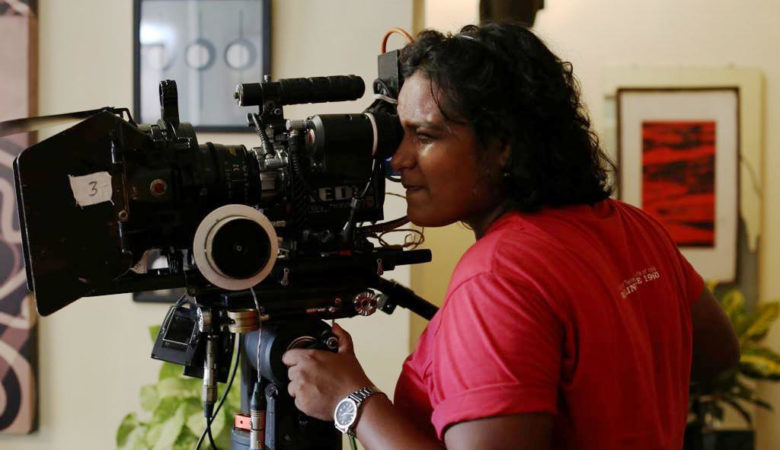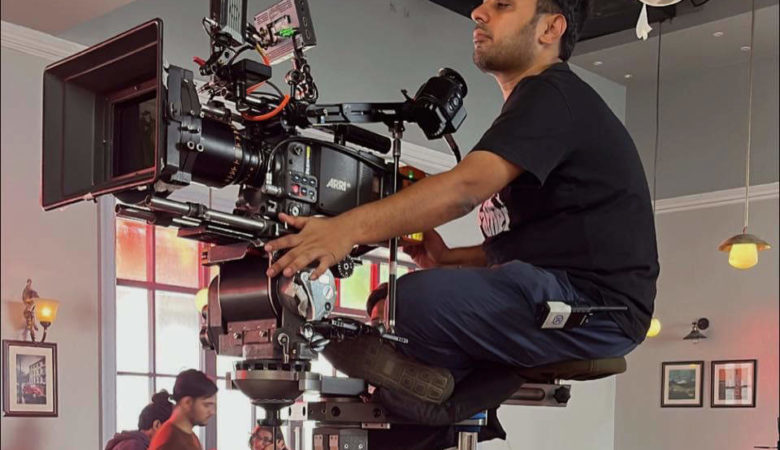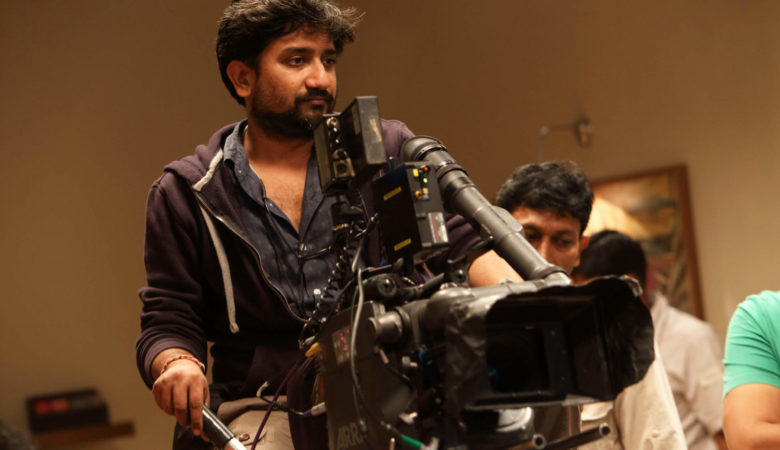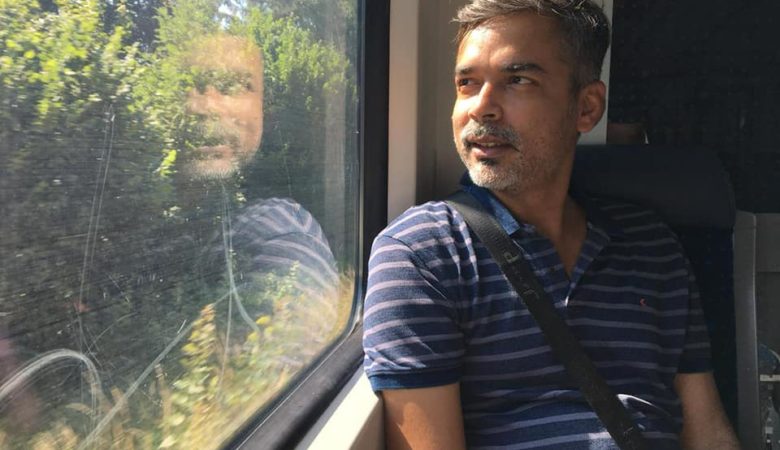Anand graduated in humanities and journalism from the University of Amaravati (Maharashtra). He then post-graduated in communication studies from the University of Pune, followed by a diploma in Cinematography from the Film and Television Institute of India (FTII), Pune. He is an amateur carpenter, an avid traveller.
As a child what were your early influences towards cinema?
I grew up in small towns of the Vidarbha region of Maharashtra. Those were the times of single screens and touring talkies. But even then, these towns/villages did not have cinema theatres. So, our elders used to get a film projector and screen films during the festivals at our village. As a little boy, I was curious about the screen on which they projected the film. It was a two-sided screen made of dhoti. I wondered how people appeared on this screen. I watched popular cinema like Gaay aur Gauri, Hatimtai, and Ajooba on that screen. It was fun to watch the films from both sides of the screen – the back side showing the reverse image. That was my first impression of cinema. Those images are still stuck in my head.
How did you first become interested in cinematography? Did you start
with photography?
I always wanted a profession related to travelling and exploring. After my graduation, I got a journalism degree and took a job in a local newspaper. I started going to the field carrying a film camera for stills. It developed my interest in looking at things through the viewfinder.
What steps did you take to train yourself?
I started capturing people and places using that office camera. It was a new experience. To get better in my job, I started looking for photography courses. I got to know about the Communication Studies department in University of Pune (now called SPPU) where they teach video production. I joined the course. I assisted seniors’ projects where I witnessed the process of making a short film for the first time ever. Then, I started shooting short films for my batchmates.
Being in Pune, how could I have not known about the iconic FTII? Through contacts, I assisted FTII diploma projects, too.
Around the same time, I also got a chance to work on an international documentary project which was a part of the trilogy, ‘BITTER SEEDS’ directed by Micha X Paled. I assisted him in direction and camera departments.
These initial years of getting a Master degree and working on student and professional projects shaped my aspirations – I wanted to be in this field and I wanted to do more. So the next step was FTII. After a couple of “waiting list” attempts, I finally got through and became an FTII student in the Cinematography department.
Have you assisted anyone? How does it help one?
Assisting different experts certainly helps. It enables you to closely observe how they come up with ideas, develop them, and execute them. From Micha, I learned how to work with non-artists and get what you want to build a story; how you should always have a plan B or C so that your project culminates into what you envisaged.
From the FTII alumni like Ashu Solanki and Devendra Golatkar, I learnt how to concentrate in the chaos. Film shooting is a chaotic process, but there is a method to it. Keeping your cool important. The idea in your head is more important than the gadget in your hand.
I have worked with Subbiah Nalla Muthu, India’s renowned wildlife filmmaker. He is an expert in finding the “meat” of a story from the raw footage and developing an engaging story. Working with him, I realised that in the nonfiction work, one needs to look for a storyline and help it evolve with creative planning.
How did your first film project come about?
That’s an interesting story. I had played a key character in Ruturaj Dhalgade’s first film “Guilty Misfits”. Yes, I had acted! When he started working on his second film, he asked me to play a character in this planned Marathi Film, ’Slambook’. I was studying cinematography in the Institute then. While working on the script, one day out of the blue, Ruturaj offered me to be the DOP. I was not going to refuse this chance and said yes! This decision proved to be a good one.
What is perhaps the most important factor for you to choose a script?
I want to know how much the director is convinced about the story and the characters. Even if the subject is universal, are they going to present it with an interesting take on it? Most importantly, how will I be able to offer perspective to the story through my work? That’s it! Oh, and the budget! (Laughs)
Is cinematography Intuitive or Is It something you learn?
It’s both. You have to learn the technique and the rules. But without your own intuition, creativity, and perspective, you can’t be a good at what you are doing. So, basically, intuition and learning are two sides of the same coin.
Tell us something about your latest film.
I’m traveling with my short film “Harawale Aahet 6 December 1956 Pasun” (Missing Since 06.12.1956). it’s my own production. I wrote, directed, shot and produced this 20 minutes film. It had its World premiere at 14th International Documentary and Short Film Festival of Kerala. It has been a part of prestigious film festivals in India and abroad including Dadasaheb Phalke International Film Festival (DPIFF), 9th Kolkata Film Festival, 11th Chennai International Documentary and Short Film Festival, Bengaluru International Short Film Festival, and 18th Tasveer Film Festival (Seattle, US).
Where do you seek inspiration from?
First inspiration comes from the script. And then I try to see how I will be able to achieve it. I like to travel and observe places, people, and things. The impressions that I make stay with me and pop up as I study the script.
What is in the kitty right now?
Apart from some commissioned work, I’m working on my first feature as a writer-director-cinematographer. I am also exploring the roles of a producer and executive producer under my own production house “Srujan Chitra”.
What’s your dream project?
Of course my first feature film that I just mentioned!
Your most memorable blunder?
(Laughs) This happened when I was shooting for a documentary. We were in a typical, rustic Maharashtra village. We were shooting an intense sequence outside a mud house. I was preparing my shot. The director was giving some instructions. I took some inserts, on his suggestion, like the cow standing in the shade, basket of onions hanging at the door, old man sitting outside the house and such. I was tilting down from the mango tree to the house entry when suddenly, I saw my director coming out of the house. What! I turned back and saw a village uncle, grinning and proud to have me made take some shots! That was fun!
Any advice to the inspiring cinematographers?
Travel a lot. Read a lot. Meet people, see, and observe a lot. Don’t be afraid to experiment.
What book, music, movie are you enjoying right now?
I usually listen to Marathi gazals by Bhimrao Panchale – they are a constant in my schedule.
On the reading front, I am reading two Marathi books – a short story book by author Gauri Deshpande, “Aahe He Asa Ahe” (this is a reread) and an international film anthology written by Sanjay Bhaskar Joshi, “Padadyawarache Vishwabhan”. You will also find at least one book by senior journalist and writer Uttam Kambale sir in my bag. He writes from the ground zero, giving a true account of human stories.
I recently watched Kaala Pani on Netflix. It’s a strongly-narrated, character-driven story.
Harawale Aahet 6 December 1956 Pasun
Episode 13 Hindi feature film teaser
Irsaal Marathi feature film trailer
Slam book Marathi feature film trailer









Leave a Reply